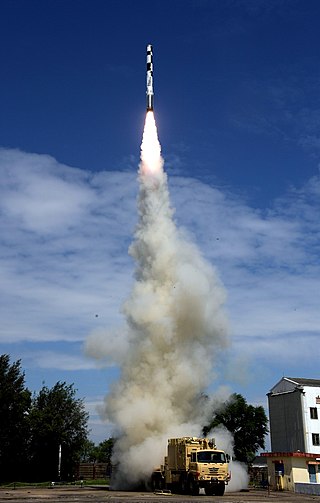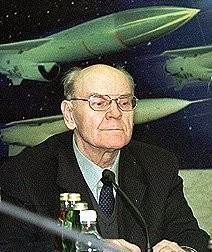
A cruise missile is an unmanned self-propelled guided vehicle that sustains flight through aerodynamic lift for most of its flight path and whose primary mission is to place an ordnance or special payload on a target. Cruise missiles are designed to deliver a large warhead over long distances with high precision. Modern cruise missiles are capable of traveling at high subsonic, supersonic, or hypersonic speeds, are self-navigating, and are able to fly on a non-ballistic, extremely low-altitude trajectory.

In aerodynamics, a hypersonic speed is one that exceeds five times the speed of sound, often stated as starting at speeds of Mach 5 and above.

A submarine-launched cruise missile (SLCM) is a cruise missile that is launched from a submarine. Current versions are typically standoff weapons known as land-attack cruise missiles (LACMs), which are used to attack predetermined land targets with conventional or nuclear payloads. Anti-ship cruise missiles (ASCMs) are also used, and some submarine-launched cruise missiles have variants for both functions.

The BrahMos is a medium-range ramjet supersonic cruise missile that can be launched from submarines, ships, fighter aircraft or TEL. It is a joint venture between the Indian Defence Research and Development Organisation (DRDO) and the Russian Federation's NPO Mashinostroyeniya, who together have formed BrahMos Aerospace. The missile is based on P-800 Oniks. The name BrahMos is a portmanteau formed from the names of two rivers, the Brahmaputra of India and the Moskva of Russia.
Scramjet programs refers to research and testing programs for the development of supersonic combustion ramjets, known as scramjets. This list provides a short overview of national and international collaborations, and civilian and military programs. The USA, Russia, India, and China (2014), have succeeded at developing scramjet technologies.

Hypersonic flight is flight through the atmosphere below altitudes of about 90 km at speeds greater than Mach 5, a speed where dissociation of air begins to become significant and high heat loads exist. Speeds over Mach 25 have been achieved below the thermosphere as of 2020.
A Sivathanu Pillai is an Indian scientist who formerly served as Honorary Distinguished Professor at Indian Space Research Organisation (2015–2018) and an honorary professor at IIT Delhi in the Department of Mechanical Engineering (2015–2016) and a visiting professor at Indian Institute of Science (2014–2015).

The HSTDV is an unmanned scramjet demonstration aircraft for hypersonic flight. It is being developed as a carrier vehicle for hypersonic and long-range cruise missiles, and will have multiple civilian applications including the launching of small satellites at low cost. The HSTDV program is being run by the Defence Research and Development Organisation (DRDO).
The Indian Air Force has been undergoing a modernization program to replace and upgrade outdated equipment since the late 1990s to meet modern standards. For that reason, it has started procuring and developing aircraft, weapons, associated technologies, and infrastructures. Some of these programs date back to the late 1980s. The primary focus of current modernization and upgrades is to replace aircraft purchased from the Soviet Union that currently form the backbone of the Air Force.

The BrahMos Aerospace is an Indo-Russian multinational aerospace and defense corporation, with core manufacturing concentrations in Cruise missiles. Headquartered in New Delhi, India, it was founded as a joint venture between the India's Defence Research and Development Organisation and NPO Mashinostroyenia of Russia. Company's name is a portmanteau formed from the names of two rivers, the Brahmaputra of India and the Moskva of Russia.

An air-launched cruise missile (ALCM) is a cruise missile that is launched from a military aircraft. Current versions are typically standoff weapons which are used to attack predetermined land targets with conventional, nuclear or thermonuclear payloads.
India has studied, produced and used various strategic and tactical missile systems since its independence. Decades long projects have realised development of all types of missile systems including ballistic, cruise, anti-ship, air-defence, air-to-air and anti-missile systems. India is one of seven countries in the world with intercontinental ballistic missiles (ICBMs) and one of four countries with anti-ballistic missile systems. Since 2016, India has been a member of Missile Technology Control Regime (MTCR).

GerbertAleksandrovich Yefremov is a Soviet and Russian scientist, design engineer and Professor of Technical Sciences.
The Chaoxun-1 (CX-1) is a Chinese-built supersonic anti-ship missile and cruise missile. The missile was first displayed at the 10th China International Aviation and Aerospace Exhibition, held November 2014 in Zhuhai, China.
The 3M22 Zircon, also spelled as Tsirkon is a Russian scramjet-powered, nuclear-capable hypersonic cruise missile. Produced by NPO Mashinostroyeniya for the Russian Navy, the missile utilizes the ZS-14 launch platforms on frigates and submarines. The missile has a reported top speed of Mach 9. The weapon was first used during Russia's invasion of Ukraine.

The Avangard is a Russian hypersonic glide vehicle (HGV) that can be carried as an MIRV payload by the UR-100UTTKh, R-36M2 and RS-28 Sarmat heavy ICBMs. It can deliver both nuclear and conventional payloads. The Avangard is reportedly capable of travelling at re-entry speeds.
Sudhir Kumar Mishra is an Indian engineer, defence scientist and civil servant. He is currently the director general at the Defence Research & Development Organisation, and the chief executive officer and managing director of BrahMos Aerospace, a joint venture between India's and Russia's ministries of defence.

A hypersonic weapon is a weapon capable of travelling at hypersonic speed, defined as between 5 and 25 times the speed of sound or about 1 to 5 miles per second.
The Hypersonic Attack Cruise Missile (HACM) is a scramjet-powered hypersonic air-launched cruise missile project, the successor of the Hypersonic Air-breathing Weapon Concept (HAWC) and the SCIFiRE hypersonic programs.











